Experimental Analysis of the Low-Velocity Impact and CAI Properties of 3D Four-Directional Braided Composites after Hygrothermal Aging
Abstract
:1. Introduction
- (1)
- The hygrothermal aging of 3D4d-BC was performed to analyze the hygroscopic behavior and thermal stability of 3D4d-BC under different hygrothermal aging conditions and different braiding angles (15°/30°);
- (2)
- An LVI test was carried out to analyze the influence of the hygrothermal aging process on the impact resistance of specimens;
- (3)
- A CAI experiment and DIC damage analysis were used to analyze the influence of the hygrothermal aging process on the residual compression properties of the specimens.
2. Materials and Process
2.1. Materials and Equipment
2.2. Hygrothermal Aging
2.3. Low-Velocity Impact Test (LVI)
2.4. Compression after Impact Test (CAI)
3. Analysis of Hygrothermal Aging
3.1. Mass Change Rate of Different Braided Angles after Hygrothermal Aging Process
- (1)
- The moisture absorption rate and moisture absorption equilibrium content of the material with the same braiding angle increase with an increase in temperature. Specifically, H15 is soaked at 70 °C and reaches moisture absorption equilibrium (about 1.5%) at an aging time of 17 d (about 400 h). At 40 °C-soak, the moisture absorption equilibrium (about 1.0%) is reached at an aging time of 40 days (about 960 h). With the increase in temperature, the time to reach the moisture absorption equilibrium is shortened by 58.33%, and the moisture absorption equilibrium is increased by nearly 50%. This is due to the increase in temperature, which directly affects the speed of movement of the water molecules. When the aging temperature is 70 °C, the interaction between the fiber and the matrix will be more affected, resulting in the separation of the two, and more water molecules will enter the gap between the two.
- (2)
- The increase in humidity increases the hygroscopic equilibrium content and hygroscopic rate of H15 and H30. With the increase in humidity, the time to reach the moisture absorption equilibrium content was shortened by 42.86%, and the moisture absorption equilibrium content was increased by nearly 25%. Specifically, H15 when soaked at 70 °C reaches the moisture absorption equilibrium content (about 1.5%) at 17 d of aging time (about 400 h). At 70 °C/85% RH, the moisture absorption equilibrium content (about 1.2%) is reached at 30 d (about 700 h) of aging time;
- (3)
- The larger weaving angle shows a lower moisture absorption equilibrium content throughout the aging process, and it has little effect on the moisture absorption rate. This is because when the weaving angle is larger, the transverse arrangement of the fibers becomes tighter. The hygrothermal aging behavior of resin matrix composites is mainly affected by the epoxy resin matrix and fiber/matrix interface. Therefore, there is a significant difference in the moisture absorption equilibrium content, but it has little effect on the moisture absorption rate.
3.2. SEM Analysis
3.3. Analysis of Different Braided Angles after Hygrothermal Aging via TGA
4. LVI Test and Experimental Results
4.1. Analysis of Impact Behavior Response
4.2. Damage of Impact Analysis by C-Scan
5. CAI Test and Experimental Results
5.1. Analysis of Impact Experiment Grouping Results
5.2. Analysis of DIC Monitoring with Respect to the Damage Evolution Process
6. Conclusions
- (1)
- In the process of hygrothermal aging, a smaller braided angle leads to a lower equilibrium moisture absorption content. As a result, it has lower peak impact loads, greater structural integrity, and higher residual compressive strength;
- (2)
- SEM images show that after the hygrothermal aging treatment, the oxidation and hydrolysis of the substrate surface will lead to the degradation of the substrate. Under complex stress conditions, microcracks will form on the surface of the matrix. This is the main reason for the degradation of the properties of composite materials due to the effect of hygrothermal aging;
- (3)
- The intervention of oxygen molecules will degrade the properties of the fiber/matrix interface in the specimen and directly affect the residual compression performance of the specimen;
- (4)
- The LVI test shows that temperature has a positive effect on the water absorption behavior of the epoxy resin matrix. Higher water absorption will improve the toughness of the specimen and improve the impact resistance of the specimen slightly. But at the same time, after the aging process of the specimen, the water absorption behavior of the matrix will further cause the separation of the fiber/matrix interface. This will lead to a reduction in the integrity of the specimen, and the residual compression property will also be reduced, affecting the strength and durability of the material
- (5)
- The CAI test shows that the failure occurs from the impact point and extends to both sides through the impact point. The braided angle will cause different forms of compression failure. The brittle failure occurs in H15, the fracture occurs along the transverse, and the failure form is buckling failure. The plastic failure occurs in H30, the fracture occurs along a 45° direction, and the failure form is shear failure.
Author Contributions
Funding
Institutional Review Board Statement
Informed Consent Statement
Data Availability Statement
Conflicts of Interest
References
- Hsissou, R.; Seghiri, R.; Benzekri, Z.; Hilali, M.; Rafik, M.; Elharfi, A. Polymer Composite Materials: A Comprehensive Review. Compos. Struct. 2021, 262, 113640. [Google Scholar] [CrossRef]
- Paraye, P.; Sarviya, R.M. Advances in Polymer Composites, Manufacturing, Recycling, and Sustainable Practices. Polym.-Plast. Technol. Mater. 2024, 63, 1474–1497. [Google Scholar] [CrossRef]
- Zhang, Y.; Yan, S.; Jiang, L.; Fan, T.; Zhai, J.; Li, H. Couple effects of multi-impact damage and CAI capability on NCF composites. Rev. Adv. Mater. Sci. 2024, 63, 20240003. [Google Scholar] [CrossRef]
- Ogbonna, V.E.; Popoola, A.P.I.; Popoola, O.M.; Adeosun, S.O. A Review on Corrosion, Mechanical, and Electrical Properties of Glass Fiber-Reinforced Epoxy Composites for High-Voltage Insulator Core Rod Applications: Challenges and Recommendations. Polym. Bull. 2022, 79, 6857–6884. [Google Scholar] [CrossRef]
- Gao, S.; Hou, W.; Xing, J.; Sang, L. Numerical and Experimental Investigation of Flexural Properties and Damage Behavior of CFRTP/Al Laminates with Different Stacking Sequence. Appl. Sci. 2023, 13, 1667. [Google Scholar] [CrossRef]
- Biagini, D.; Pascoe, J.-A.; Alderliesten, R. Investigation of Compression after Impact Failure in Carbon Fiber Reinforced Polymers Using Acoustic Emission. J. Compos. Mater. 2023, 57, 1819–1832. [Google Scholar] [CrossRef]
- Haris, N.I.N.; Hassan, M.Z.; Ilyas, R.A.; Suhot, M.A.; Sapuan, S.M.; Dolah, R.; Mohammad, R.; Asyraf, M.R.M. Dynamic Mechanical Properties of Natural Fiber Reinforced Hybrid Polymer Composites: A Review. J. Mater. Res. Technol. 2022, 19, 167–182. [Google Scholar] [CrossRef]
- Zhang, Y.; Ma, J.; Wu, C.; Han, X.; Zhang, W.; Zhang, W. Effects of Moisture Ingress on the Mesoscale Mechanical Properties of Epoxy Adhesives under Elevated Temperature. Polym. Test. 2021, 94, 107049. [Google Scholar] [CrossRef]
- Chowdhury, I.R.; O’Dowd, N.P.; Comer, A.J. Experimental Study of Hygrothermal Ageing Effects on Failure Modes of Non-Crimp Basalt Fibre-Reinforced Epoxy Composite. Compos. Struct. 2021, 275, 114415. [Google Scholar] [CrossRef]
- Robert, C.; Pecur, T.; Maguire, J.M.; Lafferty, A.D.; McCarthy, E.D.; Brádaigh, C.M.Ó. A Novel Powder-Epoxy Towpregging Line for Wind and Tidal Turbine Blades. Compos. Part B Eng. 2020, 203, 108443. [Google Scholar] [CrossRef]
- Grammatikos, S.A.; Evernden, M.; Mitchels, J.; Zafari, B.; Mottram, J.T.; Papanicolaou, G.C. On the Response to Hygrothermal Aging of Pultruded FRPs Used in the Civil Engineering Sector. Mater. Des. 2016, 96, 283–295. [Google Scholar] [CrossRef]
- Pernas-Sánchez, J.; García-Rodríguez, S.M.; Artero-Guerrero, J.A.; López-Puente, J.; Costa, J. High Velocity Impact Response of Carbon/Epoxy Composite Laminates at Cryogenic Temperatures. Compos. Part A Appl. Sci. Manuf. 2023, 168, 107456. [Google Scholar] [CrossRef]
- Wang, P.; Wu, H.-L.; Leung, C.K.Y. Hygrothermal Aging Effect on the Water Diffusion in Glass Fiber Reinforced Polymer (GFRP) Composite: Experimental Study and Numerical Simulation. Compos. Sci. Technol. 2022, 230, 109762. [Google Scholar] [CrossRef]
- Liu, S.; Cheng, X.; Zhang, Q.; Zhang, J.; Bao, J.; Guo, X. An Investigation of Hygrothermal Effects on Adhesive Materials and Double Lap Shear Joints of CFRP Composite Laminates. Compos. Part B Eng. 2016, 91, 431–440. [Google Scholar] [CrossRef]
- Messana, A.; Airale, A.G.; Ferraris, A.; Sisca, L.; Carello, M. Correlation between Thermo-Mechanical Properties and Chemical Composition of Aged Thermoplastic and Thermosetting Fiber Reinforced Plastic Materials. Mater. Und Werkst. 2017, 48, 447–455. [Google Scholar] [CrossRef]
- Guo, R.; Xian, G.; Li, C.; Hong, B.; Huang, X.; Xin, M.; Huang, S. Water Uptake and Interfacial Shear Strength of Carbon/Glass Fiber Hybrid Composite Rods under Hygrothermal Environments: Effects of Hybrid Modes. Polym. Degrad. Stab. 2021, 193, 109723. [Google Scholar] [CrossRef]
- Rudawska, A. The Effect of the Salt Water Aging on the Mechanical Properties of Epoxy Adhesives Compounds. Polymers 2020, 12, 843. [Google Scholar] [CrossRef] [PubMed]
- Lu, C.; Lu, Z.; Li, Z.; Leung, C.K.Y. Effect of Graphene Oxide on the Mechanical Behavior of Strain Hardening Cementitious Composites. Constr. Build. Mater. 2016, 120, 457–464. [Google Scholar] [CrossRef]
- Wang, K.; Chen, Y.; Long, H.; Baghani, M.; Rao, Y.; Peng, Y. Hygrothermal Aging Effects on the Mechanical Properties of 3D Printed Composites with Different Stacking Sequence of Continuous Glass Fiber Layers. Polym. Test. 2021, 100, 107242. [Google Scholar] [CrossRef]
- Fiore, V.; Calabrese, L.; Miranda, R.; Badagliacco, D.; Sanfilippo, C.; Palamara, D.; Valenza, A.; Proverbio, E. An Experimental Investigation on Performances Recovery of Glass Fiber Reinforced Composites Exposed to a Salt-Fog/Dry Cycle. Compos. Part B Eng. 2023, 257, 110693. [Google Scholar] [CrossRef]
- Capiel, G.; Uicich, J.; Arrosio, F.; Fasce, D.; Morán, J.; Montemartini, P.E. pH Effect on Epoxy-Anhydride Water Aging. Polym. Degrad. Stab. 2021, 193, 109747. [Google Scholar] [CrossRef]
- Scida, D.; Assarar, M.; Poilâne, C.; Ayad, R. Influence of Hygrothermal Ageing on the Damage Mechanisms of Flax-Fibre Reinforced Epoxy Composite. Compos. Part B Eng. 2013, 48, 51–58. [Google Scholar] [CrossRef]
- Lu, L.; Gao, M.; Guo, Y.; Wang, W.; Yan, H.; Jiang, T. Experiments on Flexural Behavior of the Prefabricated RAC and NWC Composite Slab. Ain Shams Eng. J. 2022, 13, 101789. [Google Scholar] [CrossRef]
- Guermazi, N.; Tarjem, A.B.; Ksouri, I.; Ayedi, H.F. On the Durability of FRP Composites for Aircraft Structures in Hygrothermal Conditioning. Compos. Part B Eng. 2016, 85, 294–304. [Google Scholar] [CrossRef]
- Doğan, N.F.; Oğuz, Z.A.; Erkliğ, A. An Experimental Study on the Hydrothermal Aging Effect on the Free Vibration Properties of Hybrid Aramid/Glass/Epoxy Composites: Comparison of Sea Water and Distilled Water. Polym. Compos. 2023, 44, 6902–6912. [Google Scholar] [CrossRef]
- Wang, B.; Ci, S.; Di, C.; Yu, J.; Zhu, B.; Qiao, K. Effects of Hygrothermal and Salt Mist Ageing on the Properties of Epoxy Resins and Their Composites. Polymers 2022, 15, 725. [Google Scholar] [CrossRef] [PubMed]
- Pegoretti, A.; Penati, A. Recycled Poly(Ethylene Terephthalate) and Its Short Glass Fibres Composites: Effects of Hygrothermal Aging on the Thermo-Mechanical Behaviour. Polymer 2004, 45, 7995–8004. [Google Scholar] [CrossRef]
- Karbhari, V.M.; Acharya, R.; Hong, S. Seawater Effects on Thermally Aged Ambient Cured Carbon/Epoxy Composites: Moisture Kinetics and Uptake Characteristics. Polymers 2023, 15, 2138. [Google Scholar] [CrossRef]
- Zhou, J.; Lucas, J. Hygrothermal Effects of Epoxy Resin. Part I: The Nature of Water in Epoxy. Polymer 1999, 40, 5505–5512. [Google Scholar] [CrossRef]
- Wang, M.; Xu, X.; Ji, J.; Yang, Y.; Shen, J.; Ye, M. The Hygrothermal Aging Process and Mechanism of the Novolac Epoxy Resin. Compos. Part B Eng. 2016, 107, 1–8. [Google Scholar] [CrossRef]
- Chin, J.W.; Nguyen, T.; Aouadi, K. Sorption and Diffusion of Water, Salt Water, and Concrete Pore Solution in Composite Matrices. J. Appl. Polym. Sci. 1999, 71, 483–492. [Google Scholar] [CrossRef]
- Zhang, X.; Deng, Z. Effects of Seawater Environment on the Degradation of GFRP Composites by Molecular Dynamics Method. Polymers 2022, 14, 2804. [Google Scholar] [CrossRef] [PubMed]
- Wang, Z.; Zhao, X.-L.; Xian, G.; Wu, G.; Raman, R.K.S.; Al-Saadi, S. Effect of Sustained Load and Seawater and Sea Sand Concrete Environment on Durability of Basalt- and Glass-Fibre Reinforced Polymer (B/GFRP) Bars. Corros. Sci. 2018, 138, 200–218. [Google Scholar] [CrossRef]
- Ghabezi, P.; Harrison, N.M. Hygrothermal Deterioration in Carbon/Epoxy and Glass/Epoxy Composite Laminates Aged in Marine-Based Environment (Degradation Mechanism, Mechanical and Physicochemical Properties). J. Mater. Sci. 2022, 57, 4239–4254. [Google Scholar] [CrossRef]
- Ghabezi, P.; Harrison, N.M. Indentation Characterization of Glass/Epoxy and Carbon/Epoxy Composite Samples Aged in Artificial Salt Water at Elevated Temperature. Polym. Test. 2022, 110, 107588. [Google Scholar] [CrossRef]
- Apicella, A.; Nicolais, L.; De Cataldis, C. Characterization of the Morphological Fine Structure of Commercial Thermosetting Resins through Hygrothermal Experiments. In Characterization of Polymers in the Solid State I: Part A: NMR and Other Spectroscopic Methods Part B: Mechanical Methods; Advances in Polymer Science; Springer: Berlin/Heidelberg, Germany, 1985. [Google Scholar]
- Apicella, A.; Tessieri, R.; de Cataldis, C. Sorption Modes of Water in Glassy Epoxies. J. Membr. Sci. 1984, 18, 211–225. [Google Scholar] [CrossRef]
- Karbhari, V.M.; Hassanpour, B. Water, Saltwater, and Concrete Leachate Solution Effects on Durability of Ambient-temperature Cure Carbon-epoxy Composites. J. Appl. Polym. Sci. 2022, 139, e52496. [Google Scholar] [CrossRef]
- Ghorbel, E.; Valentin, D. Hydrothermal Effects on the Physico-Chemical Properties of Pure and Glass Fiber Reinforced Polyester and Vinylester Resins. Polym. Compos. 1993, 14, 324–334. [Google Scholar] [CrossRef]
- Grohmann, C.V.S.; Sinhoreti, M.A.C.; Soares, E.F.; de Oliveira, R.F.; Souza-Júnior, E.J.d.C.; Geraldeli, S. Effect of a Polymerization Inhibitor on the Chemomechanical Properties and Consistency of Experimental Resin Composites. Braz. Dent. J. 2022, 33, 92–98. [Google Scholar] [CrossRef] [PubMed]
- Rouse, P.E. Diffusion of Vapors in Films. J. Am. Chem. Soc. 1947, 69, 1068–1073. [Google Scholar] [CrossRef]
- Roggero, A.; Caussé, N.; Dantras, E.; Villareal, L.; Santos, A.; Pébère, N. In Situ Study of the Temperature Activated Kinetics of Water Sorption in an Epoxy Varnish. Polymer 2021, 213, 123206. [Google Scholar] [CrossRef]
- Naceri, A. An Analysis of Moisture Diffusion According to Fick’s Law and the Tensile Mechanical Behavior of a Glass-Fabric-Reinforced Composite. Mech. Compos. Mater. 2009, 45, 331–336. [Google Scholar] [CrossRef]
- Manjunatha, G.; Sharma, K.V. Investigation of Effect of Hygrothermal Ageing on Physical Properties of Graphene Oxide/Epoxy Nano-Composites. Mater. Today Proc. 2022, 64, 188–193. [Google Scholar] [CrossRef]
- De Brito, M.K.T.; Dos Santos, W.R.G.; Correia, B.R.D.B.; De Queiroz, R.A.; Tavares, F.V.D.S.; Neto, G.L.D.O.; De Lima, A.G.B. Moisture Absorption in Polymer Composites Reinforced with Vegetable Fiber: A Three-Dimensional Investigation via Langmuir Model. Polymers 2019, 11, 1847. [Google Scholar] [CrossRef] [PubMed]
- Özdemir, I.; Brekelmans, W.A.M.; Geers, M.G.D. Computational Homogenization for Heat Conduction in Heterogeneous Solids. Int. J. Numer. Methods Eng. 2008, 73, 185–204. [Google Scholar] [CrossRef]
- Melro, A.R.; Camanho, P.P.; Pires, F.M.A.; Pinho, S.T. Micromechanical Analysis of Polymer Composites Reinforced by Unidirectional Fibres: Part I—Constitutive Modelling. Int. J. Solids Struct. 2013, 50, 1897–1905. [Google Scholar] [CrossRef]
- Zhou, J.; Wen, P.; Wang, S. Numerical Investigation on the Repeated Low-Velocity Impact Behavior of Composite Laminates. Compos. Part B Eng. 2020, 185, 107771. [Google Scholar] [CrossRef]
- Rezasefat, M.; Beligni, A.; Sbarufatti, C.; Amico, S.C.; Manes, A. Experimental and Numerical Study of the Influence of Pre-Existing Impact Damage on the Low-Velocity Impact Response of CFRP Panels. Materials 2023, 16, 914. [Google Scholar] [CrossRef]
- Zhang, Y.; Yan, S.; Wang, X.; Guan, Y.; Du, C.; Fan, T.; Li, H.; Zhai, J. An Experimental Investigation of the Mechanism of Hygrothermal Aging and Low-Velocity Impact Performance of Resin Matrix Composites. Polymers 2024, 16, 1477. [Google Scholar] [CrossRef]

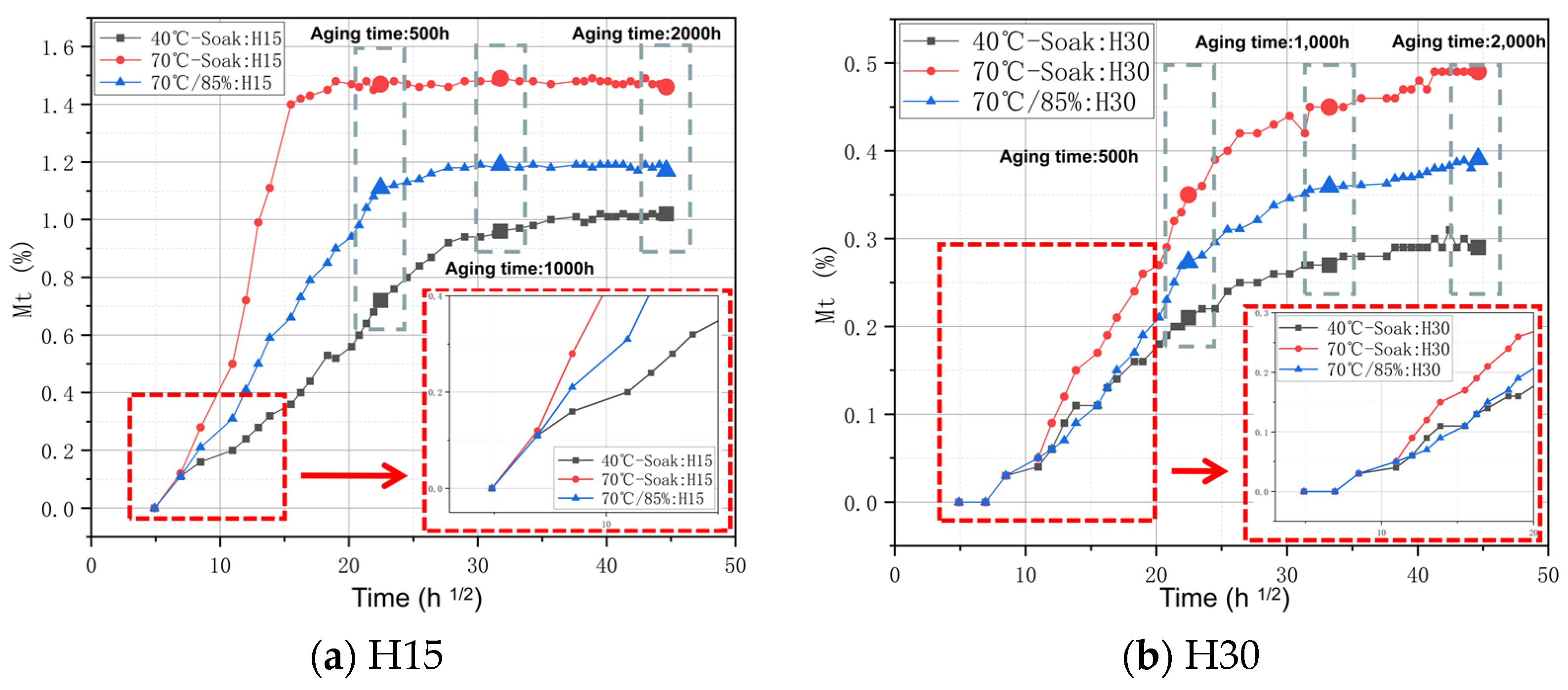
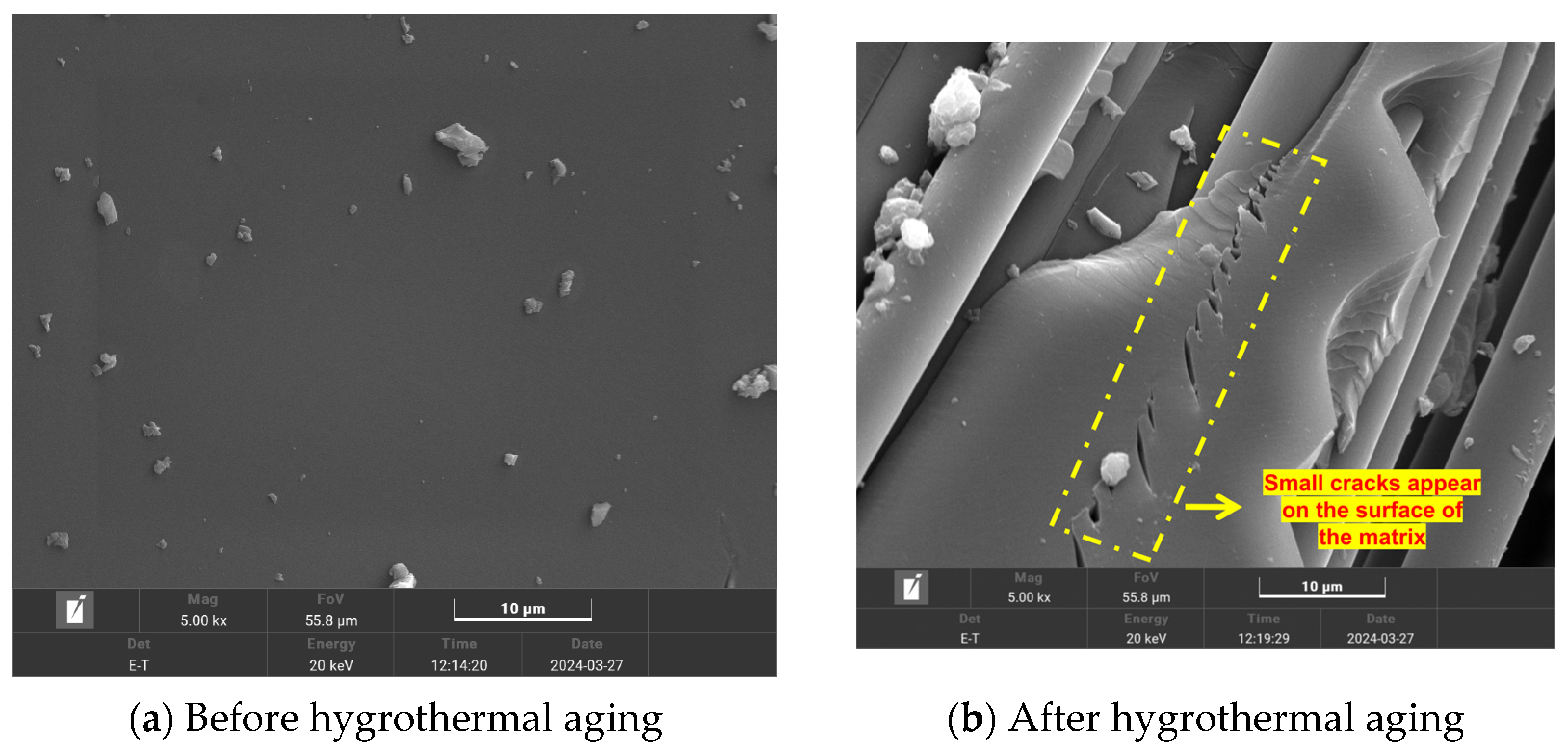


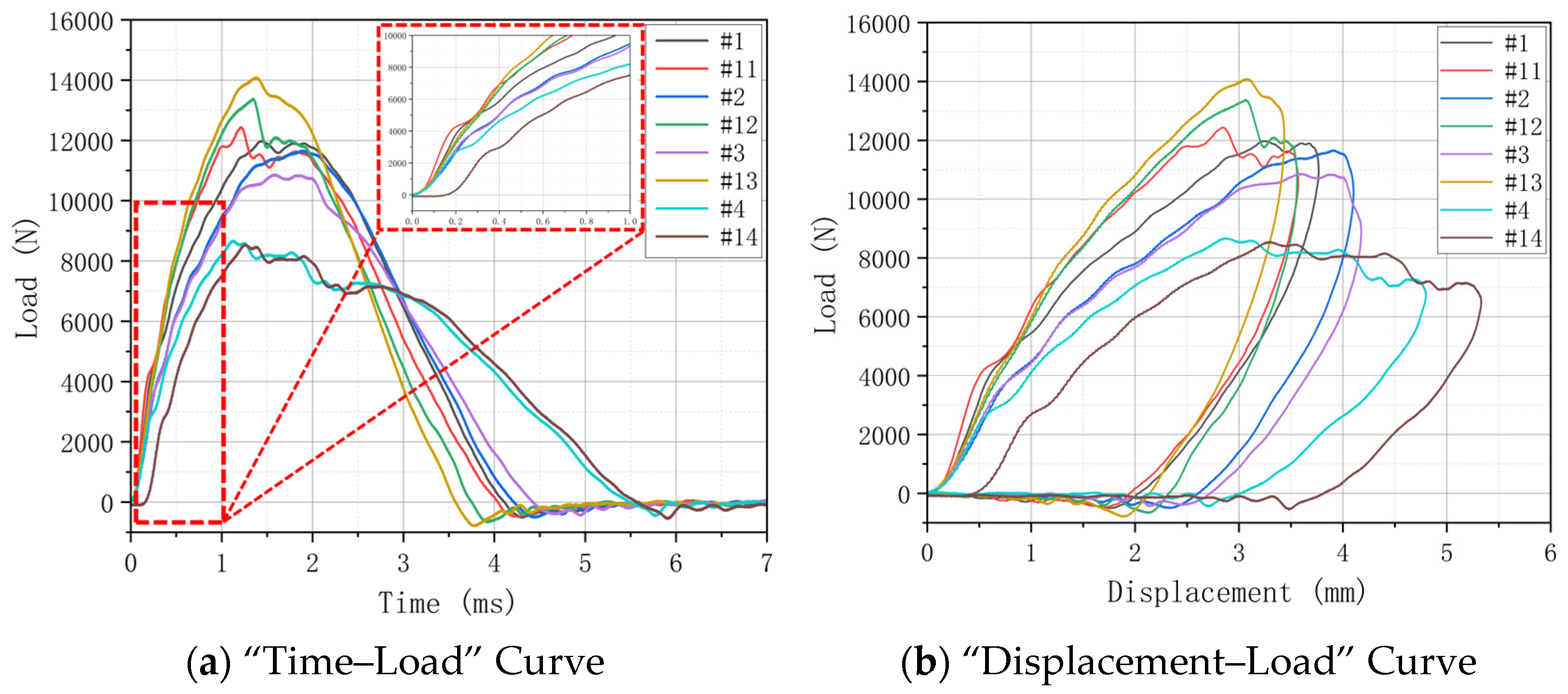

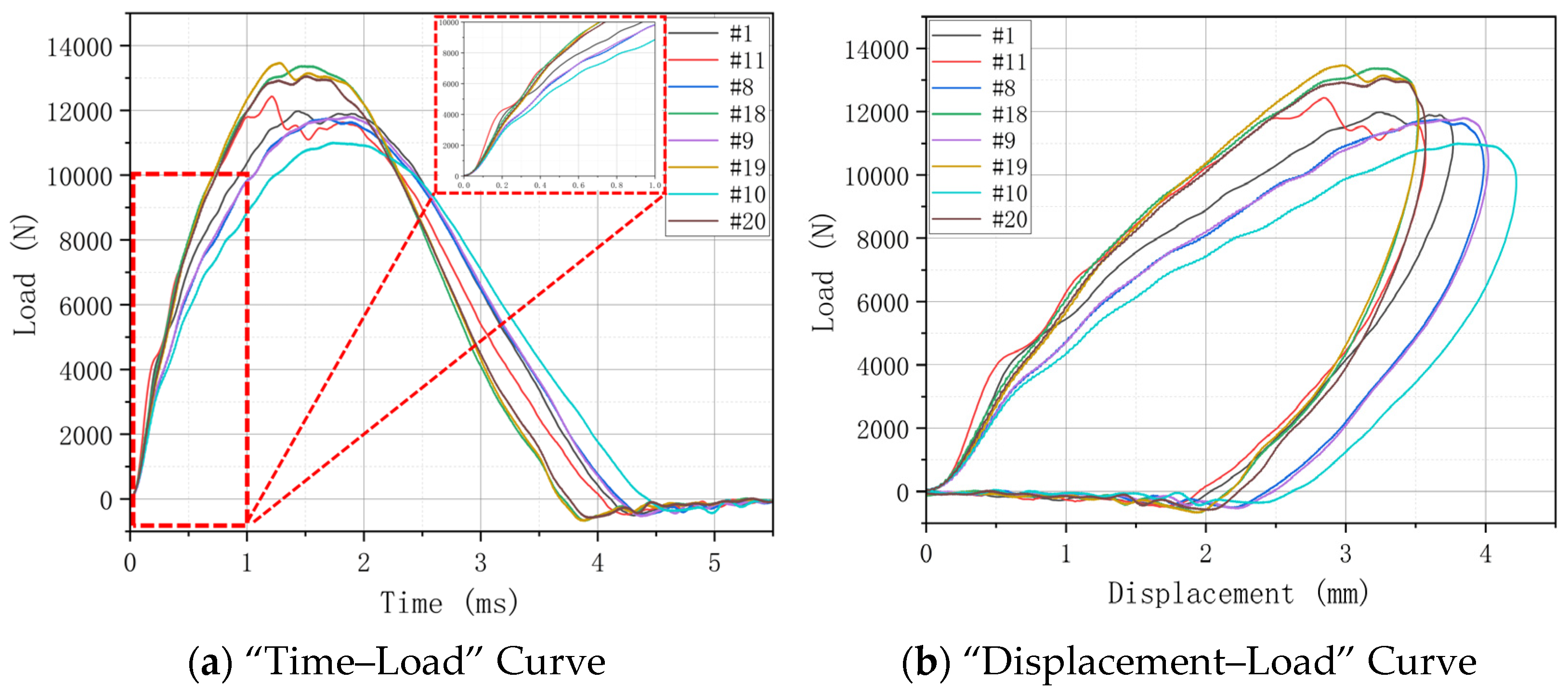
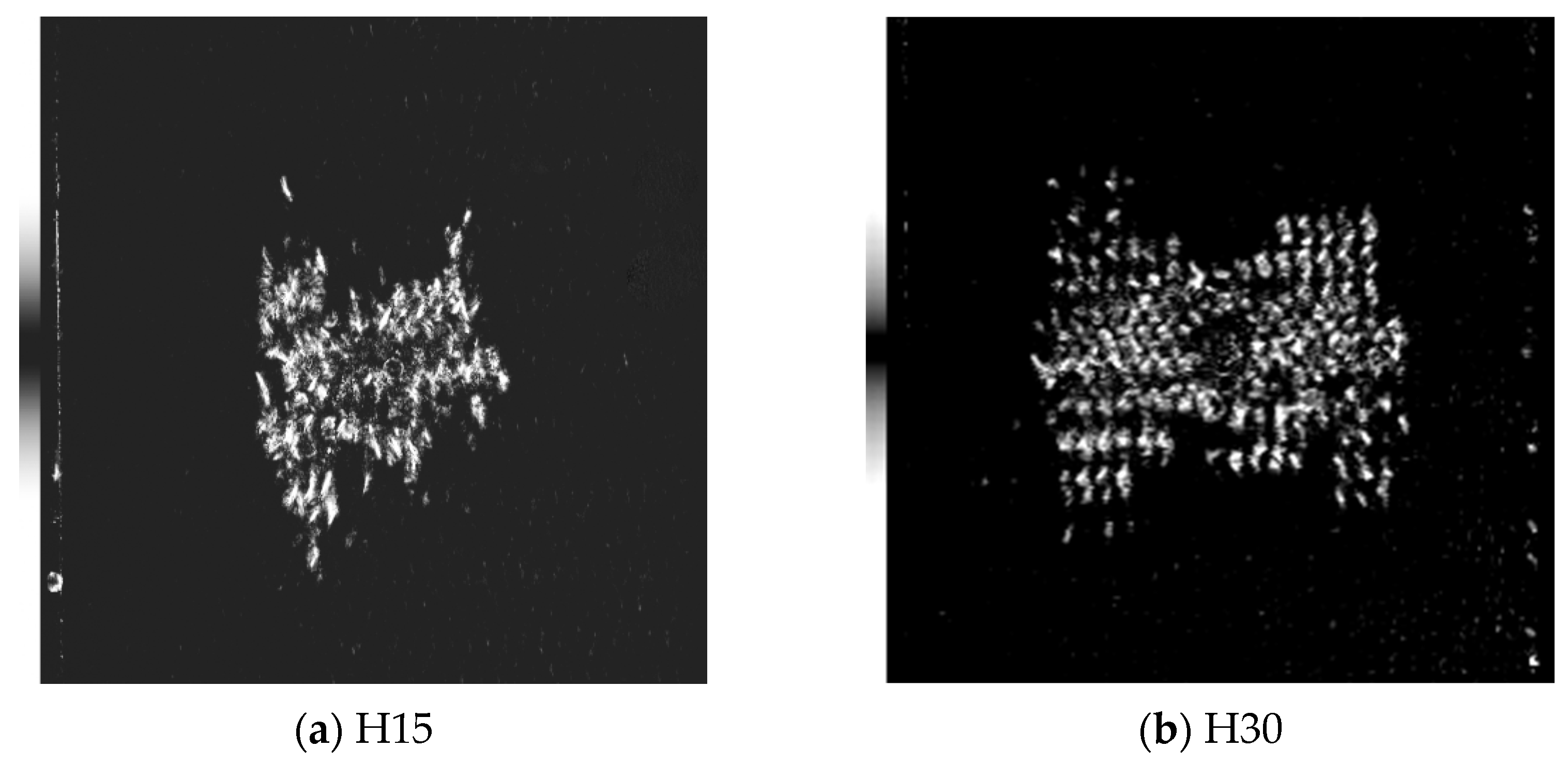
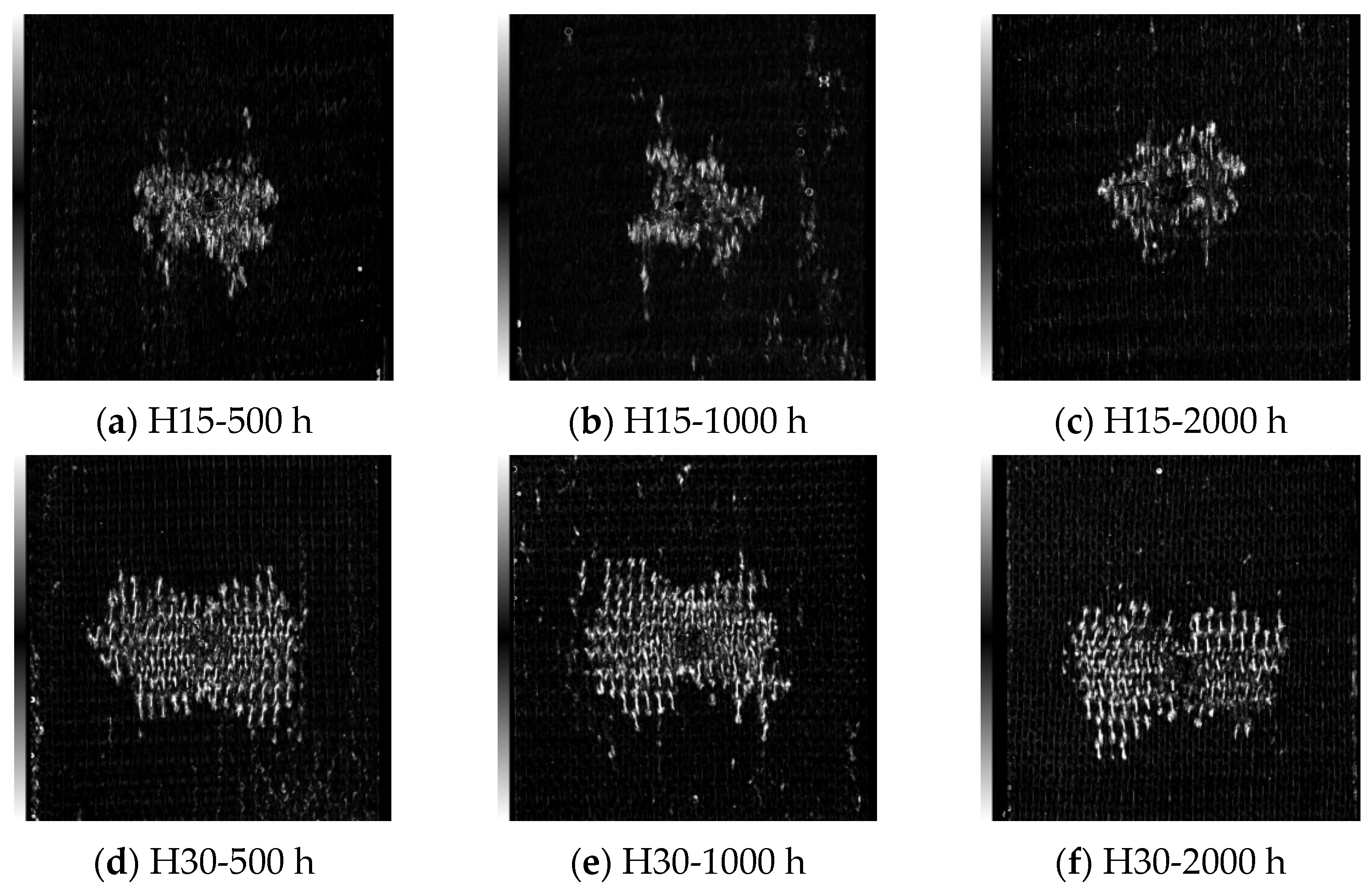


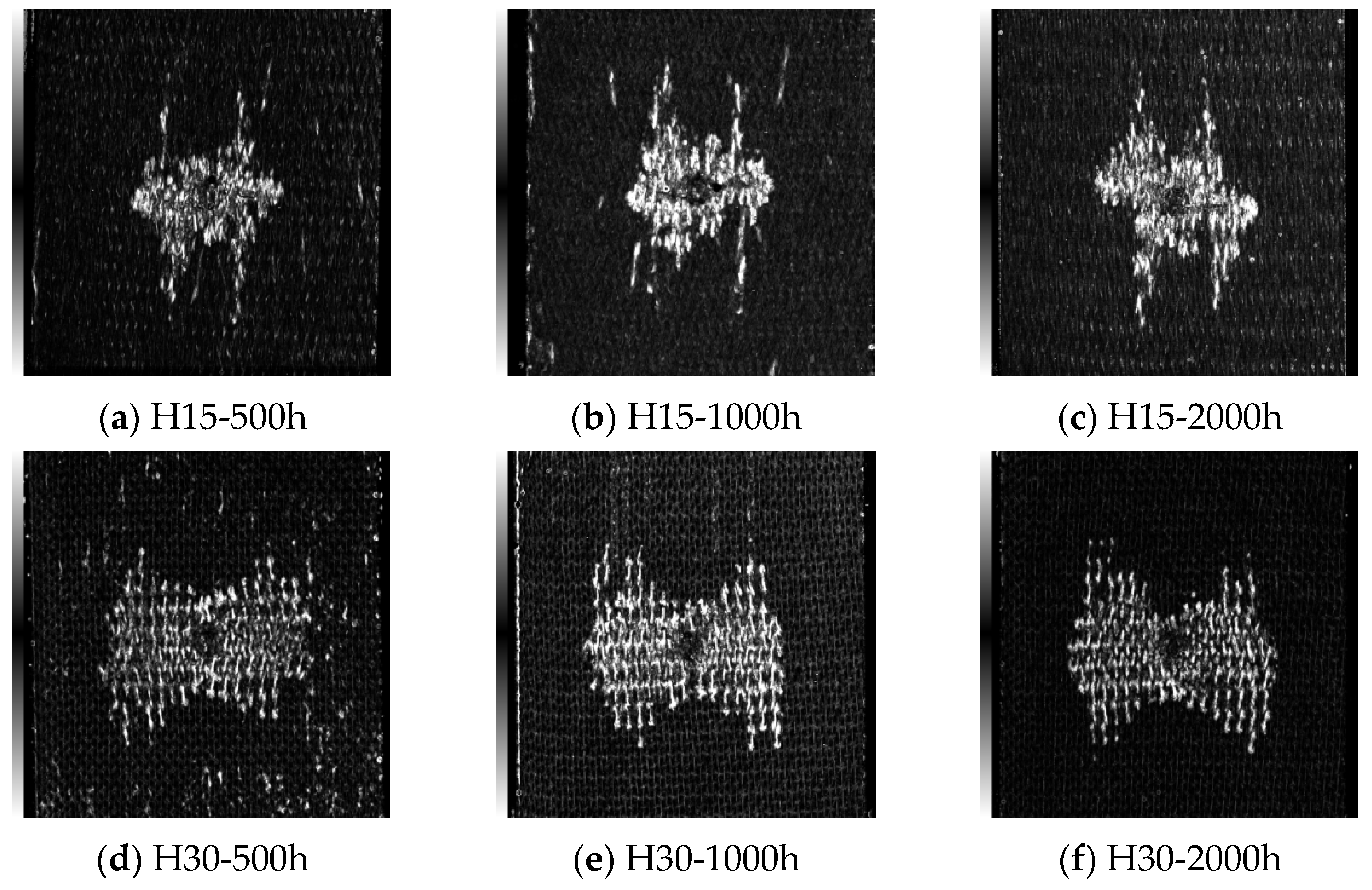



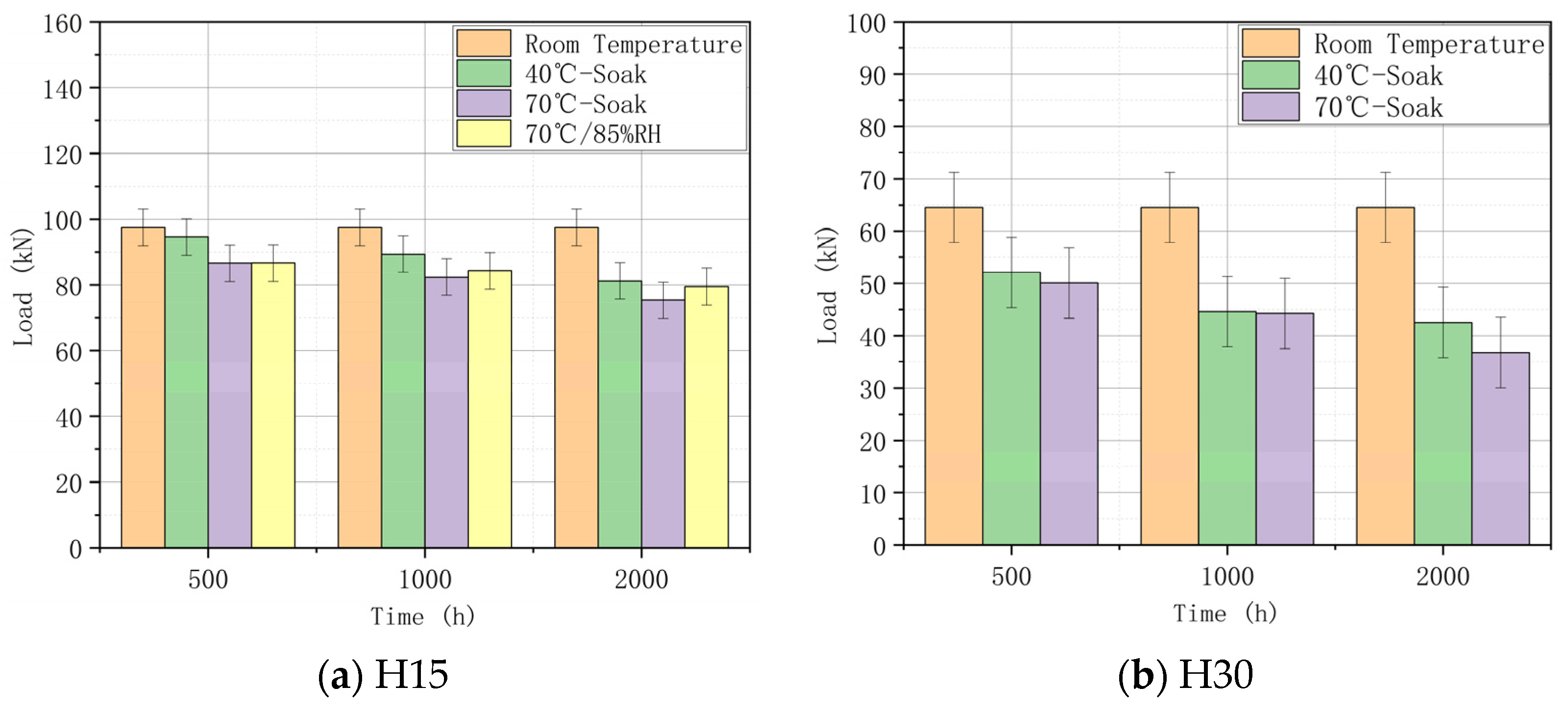


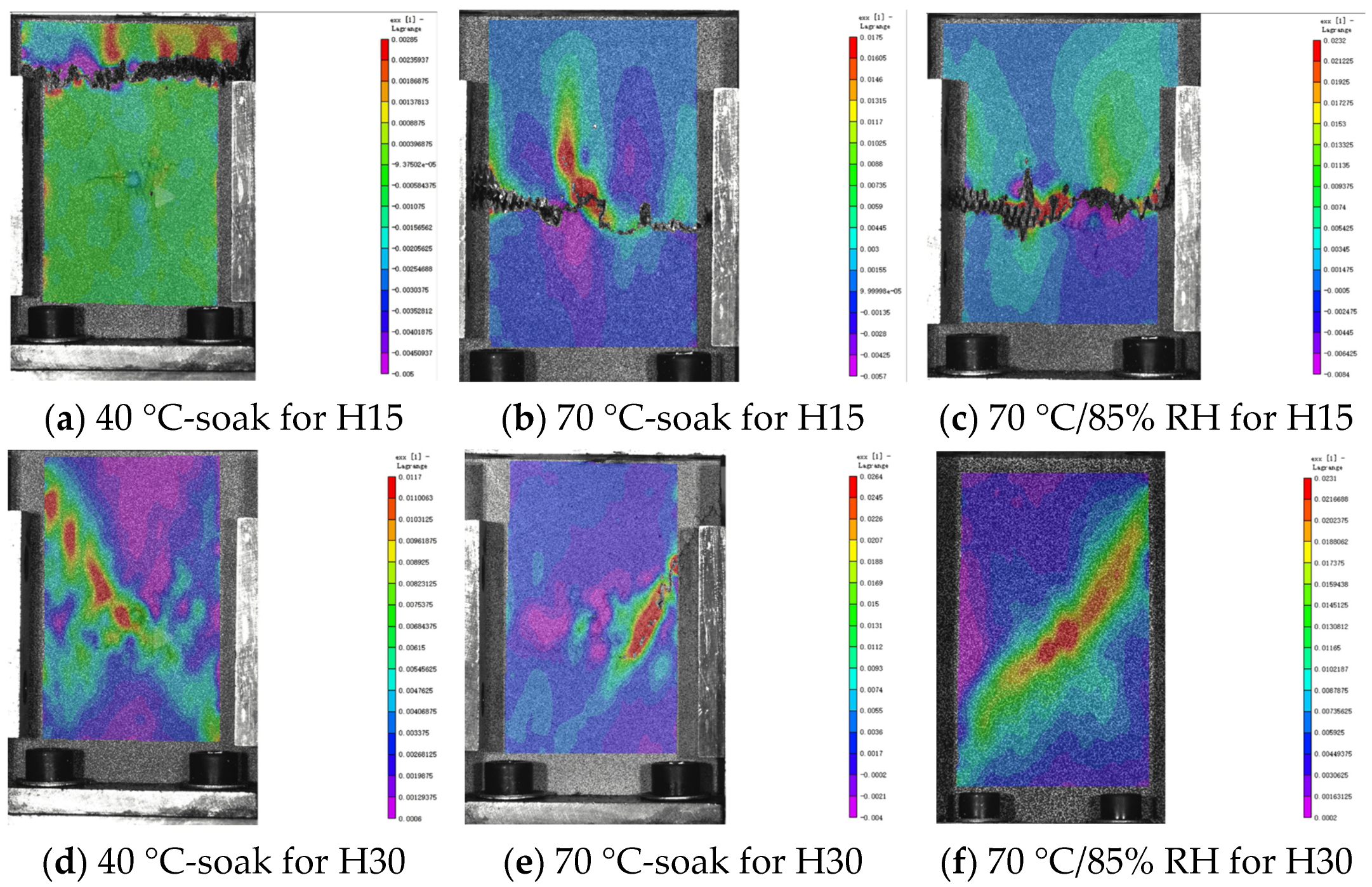


| Tape | Arguments |
|---|---|
| Carbon fiber | TORAY T700-SC-12000-50B |
| Matrix | TDE-86 epoxy resin matrix (H) |
| Fabric structure | Three-dimensional four-directional |
| Braided angle | 15° and 30° |
| Yarn fineness | 800 tex |
| Pitch length | 41.0 ± 1.0 mm (15°) 21.5 ± 1.0 mm (30°) |
| Pitch width | 11.0 ± 0.5 mm (15°) 12.5 ± 0.5 mm (30°) |
| Overall fiber volume content | (60 ± 4)% |
| Fiber filling factor | 75% |
| Equipment | Type | Main Parameter |
|---|---|---|
| Thermostatic water bath | HWY-501 | Volume: 20 L; Temperature: room temperature −80.0 °C |
| Constant temperature and humidity testing machine | JHY-H-150L | Temperature interval: −60–150 °C Humidity interval: 20–98% RH |
| Model Number | Main Parameter |
|---|---|
| Instron-9250 HV | Maximum impact energy: 826 J |
| Maximum impact velocity: 20 m/s | |
| Hammer head positioning accuracy: 0.1 mm | |
| Mass of the impact platform: 7.29 kg (mass of single head ball punch: 0.145 kg) | |
| Sonoscan-D9500 | Probe frequency: 5–400 MHz |
| Sound width: 0.25 ns–1 μm | |
| Maximum scanning area: 333 mm × 312 mm | |
| X/Y-axis accuracy: ±0.5 μm | |
| Z-axis accuracy: ±45 nm |
| Number | 15° Braided Angle | Number | 30° Braided Angle |
|---|---|---|---|
| #1 | H15-R | #11 | H30-R |
| #2 | H15-500-40 °C | #12 | H30-500-40 °C |
| #3 | H15-500-70 °C | #13 | H30-500-70 °C |
| #4 | H15-500-70 °C/85% RH | #14 | H30-500-70 °C/85% RH |
| #5 | H15-1000-40 °C | #15 | H30-1000-40 °C |
| #6 | H15-1000-70 °C | #16 | H30-1000-70 °C |
| #7 | H15-1000-70 °C/85% RH | #17 | H30-1000-70 °C/85% RH |
| #8 | H15-2000-40 °C | #18 | H30-2000-40 °C |
| #9 | H15-2000-70 °C | #19 | H30-2000-70 °C |
| #10 | H15-2000-70 °C/85%RH | #20 | H30-2000-70 °C/85% RH |
| Number | Damage Area Proportion/% | Number | Damage Area Proportion/% |
|---|---|---|---|
| #1 | 9.55 | #11 | 15.91 |
| #2 | 9.86 | #12 | 17.15 |
| #3 | 10.00 | #13 | 18.18 |
| #4 | 11.26 | #14 | 18.64 |
| #5 | 11.36 | #15 | 17.45 |
| #6 | 11.14 | #16 | 18.64 |
| #7 | 12.27 | #17 | 19.21 |
| #8 | 12.52 | #18 | 17.86 |
| #9 | 13.45 | #19 | 19.01 |
| #10 | 14.59 | #20 | 22.23 |
| Hygrothermal Aging Conditions | Residual Compressive Strength Load/kN | |
|---|---|---|
| H15 | H30 | |
| Room temperature | 97.49 | 64.54 |
| 40 °C-soak—500 h | 94.58 | 52.09 |
| 40 °C-soak—1000 h | 89.32 | 44.61 |
| 40 °C-soak—2000 h | 81.20 | 42.54 |
| 70 °C-soak—500 h | 86.60 | 50.08 |
| 70 °C-soak—1000 h | 82.40 | 44.27 |
| 70 °C-soak—2000 h | 75.32 | 36.80 |
| 70 °C/85%RH—500 h | 86.65 | 51.36 |
| 70 °C/85%RH—1000 h | 84.24 | 50.51 |
| 70 °C/85%RH—2000 h | 79.51 | 39.85 |
Disclaimer/Publisher’s Note: The statements, opinions and data contained in all publications are solely those of the individual author(s) and contributor(s) and not of MDPI and/or the editor(s). MDPI and/or the editor(s) disclaim responsibility for any injury to people or property resulting from any ideas, methods, instructions or products referred to in the content. |
© 2024 by the authors. Licensee MDPI, Basel, Switzerland. This article is an open access article distributed under the terms and conditions of the Creative Commons Attribution (CC BY) license (https://creativecommons.org/licenses/by/4.0/).
Share and Cite
Zhang, Y.; Li, H.; Yan, S.; Wang, X.; Guan, Y.; Du, C.; Jiang, L.; Zhai, J. Experimental Analysis of the Low-Velocity Impact and CAI Properties of 3D Four-Directional Braided Composites after Hygrothermal Aging. Materials 2024, 17, 3151. https://doi.org/10.3390/ma17133151
Zhang Y, Li H, Yan S, Wang X, Guan Y, Du C, Jiang L, Zhai J. Experimental Analysis of the Low-Velocity Impact and CAI Properties of 3D Four-Directional Braided Composites after Hygrothermal Aging. Materials. 2024; 17(13):3151. https://doi.org/10.3390/ma17133151
Chicago/Turabian StyleZhang, Yuxuan, Hanhua Li, Shi Yan, Xin Wang, Yue Guan, Changmei Du, Lili Jiang, and Junjun Zhai. 2024. "Experimental Analysis of the Low-Velocity Impact and CAI Properties of 3D Four-Directional Braided Composites after Hygrothermal Aging" Materials 17, no. 13: 3151. https://doi.org/10.3390/ma17133151





